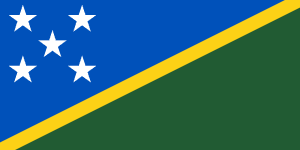
| Colors | HEX Code | RGB | CMYK |
|---|---|---|---|
| Blue | #0051BA | 0, 81, 186 | 100, 56, 0, 27 |
| White | #FFFFFF | 255, 255, 255 | 0, 0, 0, 0 |
| Yellow | #FCD116 | 252, 209, 22 | 0, 17, 91, 1 |
| Green | #215B33 | 33, 91, 51 | 64, 0, 44, 64 |
The flag of Solomon Islands has two triangles that are separated by a thin yellow diagonal stripe that runs from the lower hoist corner to the upper fly corner. The upper triangle is blue with five white five-pointed stars in an off-centered vertical line in the upper left corner of the flag, and the lower triangle is green.
Meaning of the flag of Solomon Islands
The yellow color represents the sunshine of the islands. The blue triangle signifies water as rivers, rain and the Pacific Ocean. The green triangle represents fertile land, with its trees and crops. The five stars represent the country’s five main islands.
History of the Flag of the Solomon Islands
The Solomon Islands were divided between Britain and Germany in 1886. Germany had the Eastern part, and Britain had control of the Southern part. The Solomon Islands became totally ruled by Britain and the islands became a British protectorate after WWI. During British rule, the Union jack and the Blue Ensign were hoisted with local badges that represented the country. The badges were modified in 1947 and 1956. As Solomon Islands was preparing for independence, a contest was held to choose the best design. The winning design was adopted in 1977. Solomon Islands proclaimed independence in 1978. It was the last British protectorate to become independent.